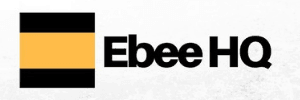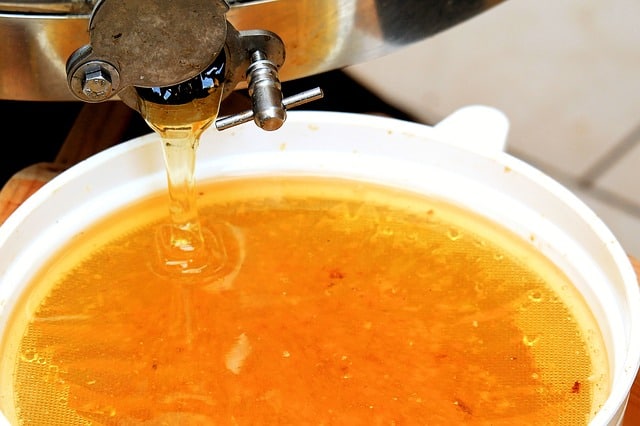Last Updated: 19 December 2025
If this is your first harvest, then you may want to focus on getting the basic equipment first.
Table of Contents
Honey Harvesting Equipment that all Beekeepers must have
The primary supplies a beekeeper needs to harvest honey will consist of a complete beekeeper suit, a hive tool, smoker with fuel, tank, strainers, honey extractor and jars to store your honey in. There’s a lot more, but we’ll just focus on the essentials.
1. Honey Harvesting Equipment
Honey extracting equipment is used to remove honey from the combs while at the same time preserving the combs’ physical state for future use.
These mechanical devices mainly feature large drums that serve as the extraction chamber where the honeycombs are placed. Once the honeycombs are harvested, they are transferred into the drums which are then set to spin at high speeds, forcing all the honey out.
Simply put, the extractor was designed to employ centrifugal force in order to extract the honey out of the comb while keeping it intact.
However, while extractors are important, you’ll also need to secure a few other things in order to properly go through the process of honey extraction.
Two of the most common types of extractors are classified as either radial or tangential extractors. Although both kinds of devices serve the same purpose, they differ in how each of their frames is positioned in the extractor basket.
Radial extractors have frames that are positioned inside the basket with the top side facing outwards while, the tangential extractor features frames that have only one side of the frame facing outwards.
Compared to the latter type of honey extracting equipment, the Radial extractors would require a lesser amount of energy to operate. For that reason, radial extractors are more often used for commercial purposes.
Additionally, extractors also come in a variety of sizes. Larger extractors are basically intended for commercial uses while the smaller ones are ideal for small-scale businesses and hobbyists. Usually, the larger types of extractors can hold over a hundred of frames at once. This allows you to extract gallons of honey in no time. However, the smaller types of extractor can hold up to three or four times at once.
However, regardless of which type of equipment you choose, you’ll have to make sure it suits the purpose as well as your budget.
Take a look at look at our list of recommended honey extractors here.
2. Beekeeping Suit
For the beginning beekeeper, safety will be your primary concern. Therefore, one of the most important aspect you will need for a harvest, is a beekeeping suit.
Since the face and neck are the most vulnerable part of the human body, a hat and veil are the most important part of your beekeeping suit. A good beekeeping suit offers ample protection from the bees stinger, protecting the beekeeper from the bee’s venom.
A full beekeeping suit consists of a lightweight, full-length overall, with a hat and veil, and gloves. Although some beekeepers find wearing gloves too cumbersome while performing delicate beekeeping tasks, gloves serve as an important part of protecting beekeeper’s hands while harvesting honey.
Bees don’t like wooly or coarse fabric so keep it smooth. Also, stay clear of any material that has an oily or animal scent, it may attract swarms of bees to you.
Make sure your suit is fully covered up and that any gaps are sealed off. It’s also a good idea to choose only thick materials that will not overheat, but at the same time will be thick enough to withstand bee stingers.
Take a look at our list of recommended bee suits here.
3. Bee Smoker
This is an important honey harvesting equipment, especially if you want to avoid stings from angry bees.
Beekeepers use a “smoker” as a way to calm the bees in order to harvest their honey. The smoke dulls their receptors and stops the guard bees from releasing an alarm signal -pheromones. It basically disorients the bees and makes them retreat deeper into the hive.
With only a few bees surrounding the frames, the process of harvesting honey is made so much easier. The smoke also makes them eat more honey, which further soothes them!
A smoker is designed to emit smoke by using various fuels. Many different natural types of fuel can be used including hessian, twine, burlap, pine needles, corrugated cardboard, or rotten wood.
4. Honey Strainer
After using a honey extracting equipment, you’ll have honey ready for packaging. But before you pour the honey in jar and brand it as your own, you’ll first need to remove any impurities.
The easiest way to do this is by using a honey strainer. You can use a regular kitchen strainer or colander, but I recommend a professional honey strainer for the job.
An effective honey strainer will separate impurities like bits of wood, bee parts, wax and any other unwanted particles from the honey. Once you’ve poured the honey through the strainer, you’ll be left with pure, clear honey that will make you proud!
5. Bee Brush
The bee brush is one tool that is usually recommended for new beekeepers. The brush is used to remove bees from the comb during harvesting. It is also used for other purposes like queen rearing, making splits and more.
The reason the bee brush is an essential tool is that it gently removes bees from the frames without killing the bees. The brush is usually made of soft bristles that are uniquely designed to remove the bees without causing any harm.
During a honey harvest, you will need the bee brush to sweep each frame before putting it into the extractor. This is one job that requires care and can be time-consuming if you have a lot of bees.
The point is to carefully remove the bees from the frame by using the brush and also positioning the frame in a way that the bees will come off without getting entangled or breaking their legs in the process.
The best way to do this is to turn the frames upside down before you start brushing. You will discover that the bees will simply fall off the frames with minimal loss to you.
Some beekeepers place the frame in an upward position and still get the same results. However, they are strategic about the way they brush,
The honeycomb is constructed in a way that both sides angle up from the middle of the comb. Because of this angle, you have to brush the bees in the same direction as the angle. Going against the angle is like going up against a tide – it will a harmful effect which can kill the bees.
6. Honey Uncapping Knife
An uncapping knife is used in making clean, quick cuts through wax cappings on the honeycomb. The wax cappings usually create an airtight seal around the cells housing the honey, and this makes it very hard to extract the honey.
With an electrically heated uncapping knife, you can easily take off the cap on a honeycomb and extract the honey easily.
Another alternative to an electric uncapping knife is a jagged edge or saw-like knife. Make sure the knife is clean, hot and dry so it mimics the effect of an electric knife before using it.
To make it hot, dip it in hot water and wipe off the water with a clean cloth before using it. Remember, you don’t want any contaminants, so you must ensure that the knife is clean and rust-free.
7. Double Uncapping Tank
This is a handy tool used to collect wax cappings as they are sliced off with an uncapping knife. An uncapping tank is great to have when harvesting honey.
These tanks are useful for processing the frames before putting them in the extractor. Simply uncap your frames over the tank and you can collect the honey in the tank.
The tank comes with a honey gate that helps you in processing the honey more effectively. It separates the wax cappings from the honey itself and helps increase your yield while reducing processing time.
8. Honey Uncapping Fork
Yet another useful honey harvesting equipment that you can’t do without is the honey uncapping fork.
Uncapping forks are used in scratching the cappings that uncapping knives missed. It’s a great tool for scratching open tough cappings on the honeycomb.
You can use it instead of an uncapping knife or simply for prying open the unyielding cells that your knife cannot open. Either way, it will do a good job every time!
9. Honey Storage Bottles or Jars
Another important honey harvesting equipment is the honey jars. You need to store the harvested honey in an airtight jar with a lid. Use a jar made with material that will preserve it for a long time.
Food-grade plastic or glass is the number one choice of many beekeepers. No matter what choice you make, it ensures that the lid of the container is airtight.

